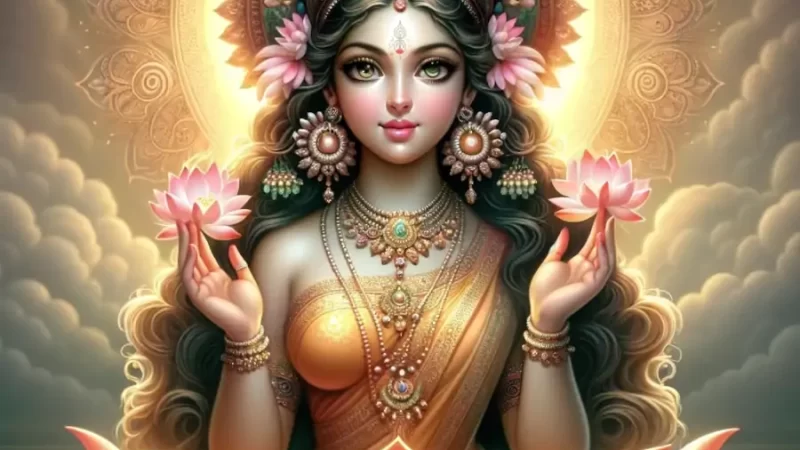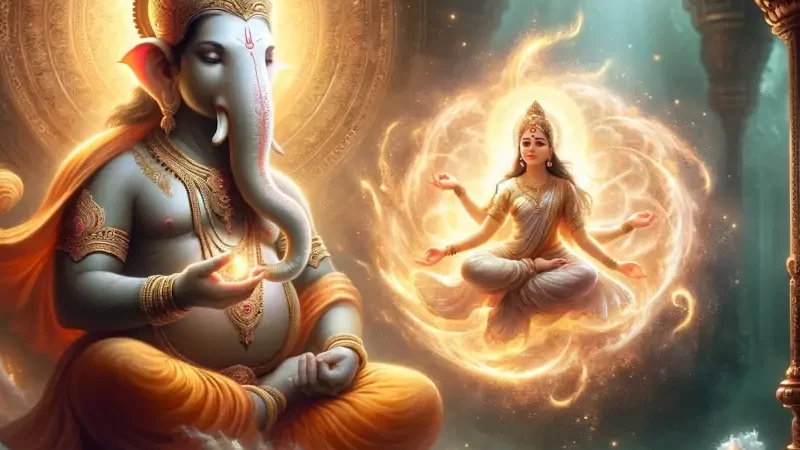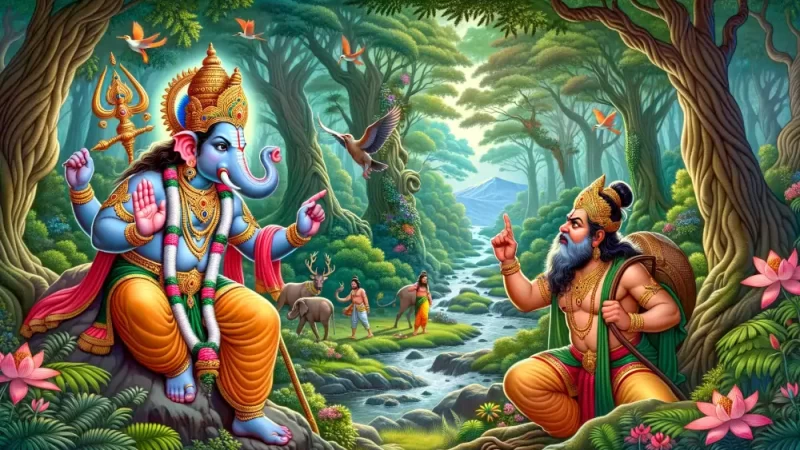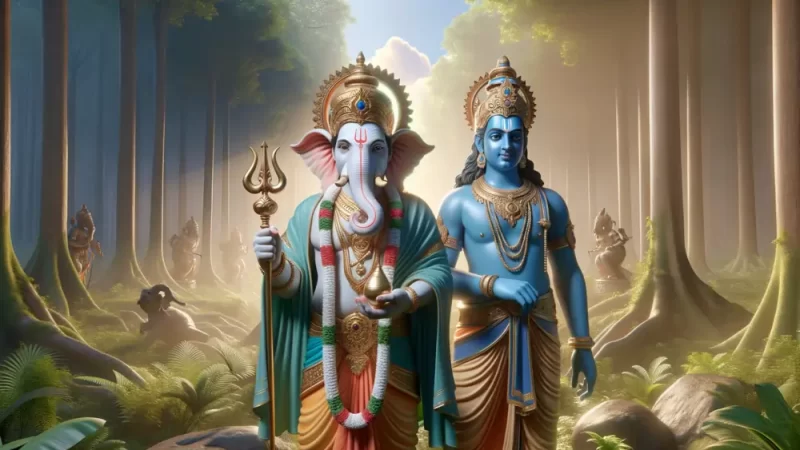The Birth of Lord Ganesha: The Elephant-Headed God with One Tusk
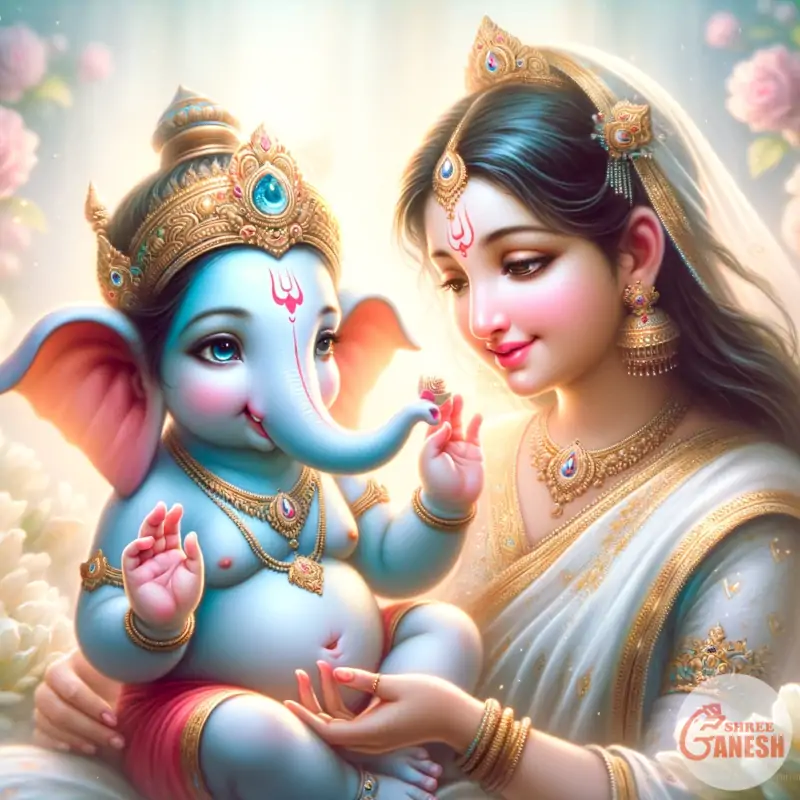
The Divine Bath and the Unwelcomed Guest
In the celestial abode of Mount Kailash, Lord Shiva and Goddess Parvati resided in blissful harmony. Their love for each other was boundless, and their life together was a symbol of devotion. However, a fascinating incident would soon unfold, leading to the birth of Lord Ganesha, the elephant-headed god with one tusk.
One day, while Goddess Parvati was preparing for her sacred bath, she instructed Lord Shiva’s faithful attendant, Nandi, not to allow anyone to enter their dwelling during her ablutions. She wished for complete privacy during this ritual.
Shiva’s Untimely Arrival
As fate would have it, Lord Shiva chose this very moment to return to their abode. Ignorant of Parvati’s bath, he approached their dwelling, expecting to enter. Nandi, who was torn between his loyalty to Shiva and his duty to Parvati, found himself in a perplexing situation. He was unsure of how to handle this predicament.
When Shiva reached the entrance and discovered that he was barred from entering, he was initially amused. Parvati, unaware of Shiva’s arrival, grew irritated, wondering why Nandi had not followed her instructions. She soon realized that Shiva was at the door, and her annoyance turned into frustration.
Parvati could not comprehend why Nandi had not stopped her husband from entering their home. She voiced her complaints to Shiva, who, in turn, found the situation quite humorous. He was intrigued by the fact that Parvati had instructed Nandi to prevent him from entering his own abode.
Parvati’s Dilemma and Her Creative Solution
Frustrated by the incident, Parvati shared her feelings with her friends, who were also divine beings residing in Mount Kailash. Her friends teased her, asserting that she had no attendant of her own and that they all considered Shiva to be their true master. These words struck a chord with Parvati, leading her to ponder a solution.
One of Parvati’s friends suggested a unique idea. To ensure that someone owed their allegiance solely to Parvati and not Shiva, they proposed creating a companion for her. This companion would serve as her loyal attendant, protecting her privacy during her sacred rituals.
The Birth of a Divine Son
Inspired by this idea, Parvati decided to proceed. She gathered saffron paste, traditionally used during bathing rituals, from her own body. With this sacred paste, she began to create a handsome and robust young boy. Her love and devotion infused life into the form she had crafted, and the boy came to life in her arms.
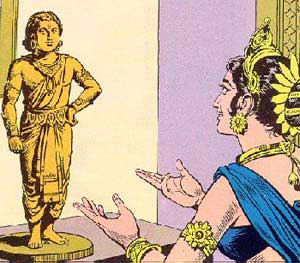
Overwhelmed with maternal affection, Parvati embraced the boy lovingly. She declared, “You are my son, my very own. I have no one else but you to call my very own.” She handed him a staff and gave him a solemn duty: to guard the door and allow no one to enter without her explicit permission.
The Encounter at the Doorway
As time passed, Lord Shiva returned to their abode, unaware of the presence of the newly created boy. As he approached the entrance, the young guardian barred his way, determined to carry out his mother’s orders.
Shiva, surprised by the boy’s appearance and authority, attempted to explain his identity and his rightful place in the dwelling. However, the boy was resolute, declaring, “Halt! No one enters these halls without my mother’s permission.” Undeterred by Shiva’s insistence, the boy used his staff to prevent Shiva from entering.
Infuriated by the boy’s defiance, Shiva’s initial amusement gave way to anger. He decided to engage the boy in combat, believing that he was no ordinary child. Shiva ordered his attendants to seize the boy, but much to their astonishment, the boy single-handedly defeated them all.
News of the battle reached Parvati through her divine friends, who quickly conveyed the events to her. Parvati realized that the boy who had been created to protect her privacy was indeed fulfilling his duty with unwavering dedication.
The Battle Escalates
Shiva, undeterred by his previous defeats, remained determined to enter the abode. He dispatched his entire army to capture the boy. Witnessing her son’s valiant struggle, Parvati called upon her divine powers, summoning Goddesses Kali and Durga to stand by her son’s side.
Shiva’s army, even in its entirety, proved powerless against the combined strength of the divine mother-son duo. Shiva’s attendants fled in fear, defeated by the extraordinary prowess of the boy.
Shiva, recognizing the gravity of the situation, sought the assistance of Lord Vishnu in his battle against the young guardian. Vishnu, joining Shiva, engaged in a fight with the boy.
The Tragic End and the Realization
As the battle unfolded, Shiva, in a moment of recklessness, hurled his formidable Trident toward the boy. Tragically, the Trident found its mark, severing the boy’s head from his body.
In the aftermath of this devastating act, Shiva realized the gravity of his actions. He was overcome with sorrow and regret. Parvati, upon hearing of the unfair battle that had unfolded, was incensed and determined to bring justice to her son.
Parvati’s Resolve and Her Conditions
Devastated by her son’s untimely demise, Parvati decided to take a drastic step. She resolved to destroy the entire world in her grief and anger. The gods, fearing the consequences of her wrath, intervened, led by Lord Brahma.
Brahma humbly approached Parvati, seeking her mercy to save the world from her impending destruction. Parvati, in her anguish, agreed to spare the world on two conditions.
“First,” she declared, “my son must be brought back to life, and second, he shall be worshipped before any other gods.” Her love for her son was unyielding, and her conditions reflected her deep maternal devotion.
The Birth of Lord Ganesha: The Elephant-Headed God
Shiva, who had now calmed down and realized the magnitude of his actions, consented to Parvati’s conditions. He instructed Lord Brahma to journey north and retrieve the head of the first living creature he encountered.
Brahma followed Shiva’s command and embarked on his mission. Before long, he came across a mighty elephant. Without hesitation, Brahma severed the elephant’s head and brought it back with him. Shiva and Parvati, with bated breath, watched as Brahma placed the elephant’s head upon the lifeless body of Parvati’s son.
Resurrection and Blessings
Brahma, using his divine powers, sprinkled holy water upon the head and body, invoking the blessings of the gods. The miracle unfolded before their eyes as the boy came back to life, now with an elephant’s head firmly affixed to his shoulders.
Parvati, overjoyed by her son’s resurrection, embraced him with boundless love. She then turned to Brahma to fulfill the second condition she had set forth. The gods, including Lord Indra, escorted Shiva to Parvati, where he humbly sought her forgiveness.
Shiva apologized for his arrogance and impulsive actions, acknowledging his mistake. He declared, “From this day forward, this valiant boy will be my son, respected as any other god. He will be worshipped before all other deities and shall be known as Ganesh, the chief of my attendants, as well as Vigneshwar, the remover of all obstacles.”

With these words, Shiva and Parvati were reconciled, and their divine abode at Mount Kailash once again became a haven of love and devotion.
The One-Tusked Ganesh and the Divine Axe
Many years later, another fascinating incident would further enhance Lord Ganesh’s unique appearance. During a fateful encounter with the Brahmin warrior Parashurama, Ganesh’s unwavering dedication to his duty would cost him one of his tusks, forever marking him as “Eka-danta,” the one-toothed god.
Today, Lord Ganesh is revered as the remover of obstacles, and his blessings are invoked before embarking on any significant venture. His iconic elephant-headed form continues to capture the hearts and devotion of millions worldwide, symbolizing wisdom, intellect, and the unwavering power of a mother’s love. Read more detail story on Ganesha and Parashurama>>
Are you interested to read more about Lord Ganesha’s stories?


